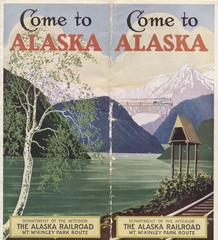Glacier Discovery train
passengers are met at 9:30 am by Conductor
Steve Culver who starts out his announcements by saying "goooooood
morning" while increasing his voice intensity. He has everyone's
attention
instantly and for the rest of the day's journey. Mr. Culver gives
commentary throughout the day on a PA system in the coach car.
In over 30 years on the Alaska Railroad, Steve has learned every inch
of this route and much its history. Five
times a week during the daily passenger season riders find out why this
conductor is the best ambassador a railroad could have! Riding on
the
Glacier Discovery with Steve is like hitting a Grand Slam.
You
will
hear history of the railroad and see wildlife, possibly a bore tide,
the ocean, rivers, waterfalls and
glaciers. In 2002 and 2003 I have
seen bear, moose, eagles, swans, salmon and sheep from the Glacier
Discovery train. You will face the facts of Alaska's
world class
scenery in the 160 miles over 12 hours you invest here. This
train is
only three cars and one locomotive and leaves the Anchorage Depot,
milepost 124, at 10
am sharp. Alaska Railroad mileposts (south to north) are numbered
from 2 at Seward to 356 at
Faifbanks. MP 0 to 2 are in Resurrection Bay at Seward, claimed
by the
1964 Good Friday earthquake. In 2003, the train consists of a
GP-38, a baggage car,
a
coach with extra large windows and a stainless steel sided RDC which
allows for travel in both directions. In 2004, the railroad may
substitute a cab car made from an ex-Amtrak F-40 locomotive
in place of the RDC.
The Glacier Discovery is an excellent
introduction to the Kenai Peninsula area of southcentral Alaska.
The train proceeds southbound from
Anchorage to Whittier via
Portage. It lingers in the area 60 miles south of Anchorage to
visit Alaskan territory inaccessable by car before returning to
Anchorage
The first order of business south of Anchorage was a "meet" at Potter
Marsh with the northbound cruise train from Seward. The Glacier
Discovery train pulled into a siding for the other train to get to
Anchorage.
After that, our train backed out onto
the mainline and
we headed south towards Portage. Southbound views on the right
side of the train are dominated by the Turnagain Arm of the Cook Inlet
of the Pacific Ocean. Across the water is the Kenai Peninsula
mountains with snow and glaciers. The left hand side view is the
Chugach Mountains which rise behind Anchorage. One particular
spot on the land side has cliffs rising upon which Dall sheep
inhabit. Most times I have been by here the sheep are too and
this day we saw them both directions. It is very common aboard
Alasaka Railroad to hear people relay throughout the car "moose, or
bear, right side!"
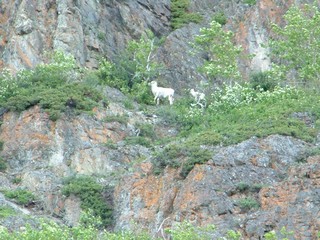
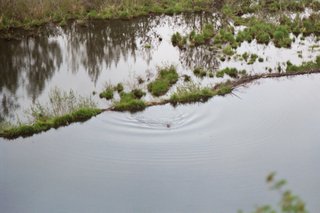
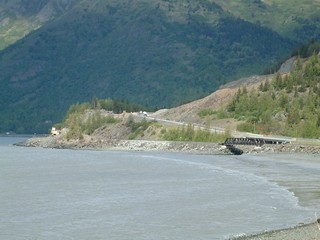
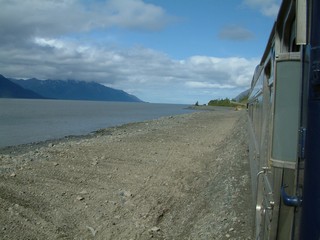
During the beautiful journey southbound,
Conductor Steve had a few minutes to visit with the children aboard the
train. We had nice weather at departure but ran into rain north
of
Portage. The Glacier Discovery reached Portage around noon and
switched onto the
Whittier Branch line for a 12 mile run from the mainline to
Whittier. The Whittier Branch was built in the early 1940's
by the Federal government during World War II. as an ice free deepwater
alternative to Seward on the coast. The port and town of
Whittier lie on the Prince William Sound. It is the barge rail
head of the Alaska Railroad to connect with the lower 48 states via
Seattle since there is no
continental rail connection to the rest of north America...yet.
The
railroad employs a modern fleet of 3 large barges
that transport rail cars and containers on top. There
is a huge barge slip to replace the one destroyed in the 1964 Good
Friday earthquake.
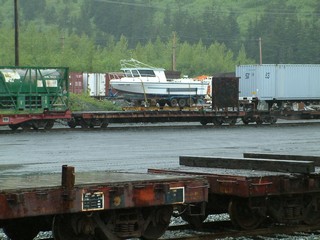
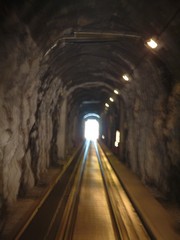
Whittier was hit hard by the quake caused tsunami and the petroleum
tank farm at the head of Passage Canal
was destroyed. Whittier was used as a military base until the
early 1960's and about 300 people presently live there. A few remnant
buildings remain, most notably the 14
story tall Begich Towers. Most residents live there and visitors
can
stay there too in June's Bed and Breakfast. Until 2000 Whittier
was
accessible only by boat, rail or
float plane-not via road. Prior to the rebuild of the second
tunnel now
renamed
Anton Anderson Memorial Tunnel, the ARR
ran a service called the Whittier Shuttle in which one could ride from
Portage to Whittier as a passenger in an ex SP gallery car or actually
drive your automobile or RV onto a railroad flat car and be transported
to the other end of the branch. Some people who drive to Whittier
take the Alaska Marine Highway System ferry boat to points such as
Valdez, Kodiak Island, or points south like Juneau, Skagway and other
inland passage locations. Sunset on the AMHS during the summer
solstice voyage from Kodiak to Seward lasts for about 4 hours!
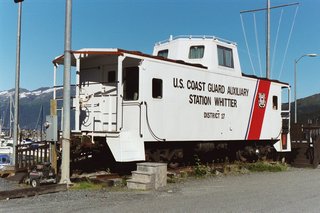
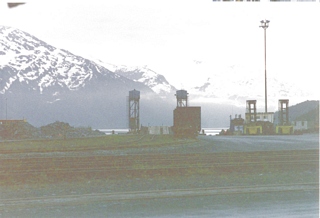
The town has a very nice small boat harbor with many
charter fishing boats for halibut or salmon. In the past I have
stayed in Whittier, gone fishing and brought home some tasty
halbut. Before we arrived in Whittier, conductor Steve announced
that the stop would be no longer than 15 minutes and that if you wanted
food from any restaurant, you had to order "to go." Your choice
was either clam chowder from Varly's Swiftwater Seafood Cafe or a quick
run
though the Korean buffet, if it was happening. Passage
Canal is a long fjord on the
western end of Prince William Sound. Some train passengers
were departing to take a 6 hour cruise of Passage Canal glaciers on
either Major Marine Tours craft or Phillip's Cruises and Tours
boat.
One tour company has a hot food buffet while the other offers their
guests meals portioned and both serve drinks and sodas at their
respective bars. These tours can be booked through the Alaska
Railroad website as package GD-2 or GD-3. The Coast Guard
Auxilary
District 17 is present in the caboose parked next to the harbormaster's
office. The train engineer and
fireman changed from the locomotive end to the RDC and after an air
test, we left town destined for Spencer Glacier.
One board the train, Conductor Culver
has a bookrack set on a coach
seat in which to display literature from local Whittier
businesses. When he works the wintertime passenger train
(Anchorage to Fairbanks) books from Shannon Cartwright, the well known
Alaskan children's author, are available.
The above two photographs show the Whittier portal of the Anton
Anderson Tunnel which is 2.5 miles in length. The right picture
shows the railroad signal set to allow train movement and automobile
gates and changeable message sign.
Glacier Discovery Page 2
Richard Elgenson
RailNews
Network Site
Email me: Richard@TrainWeb.com
